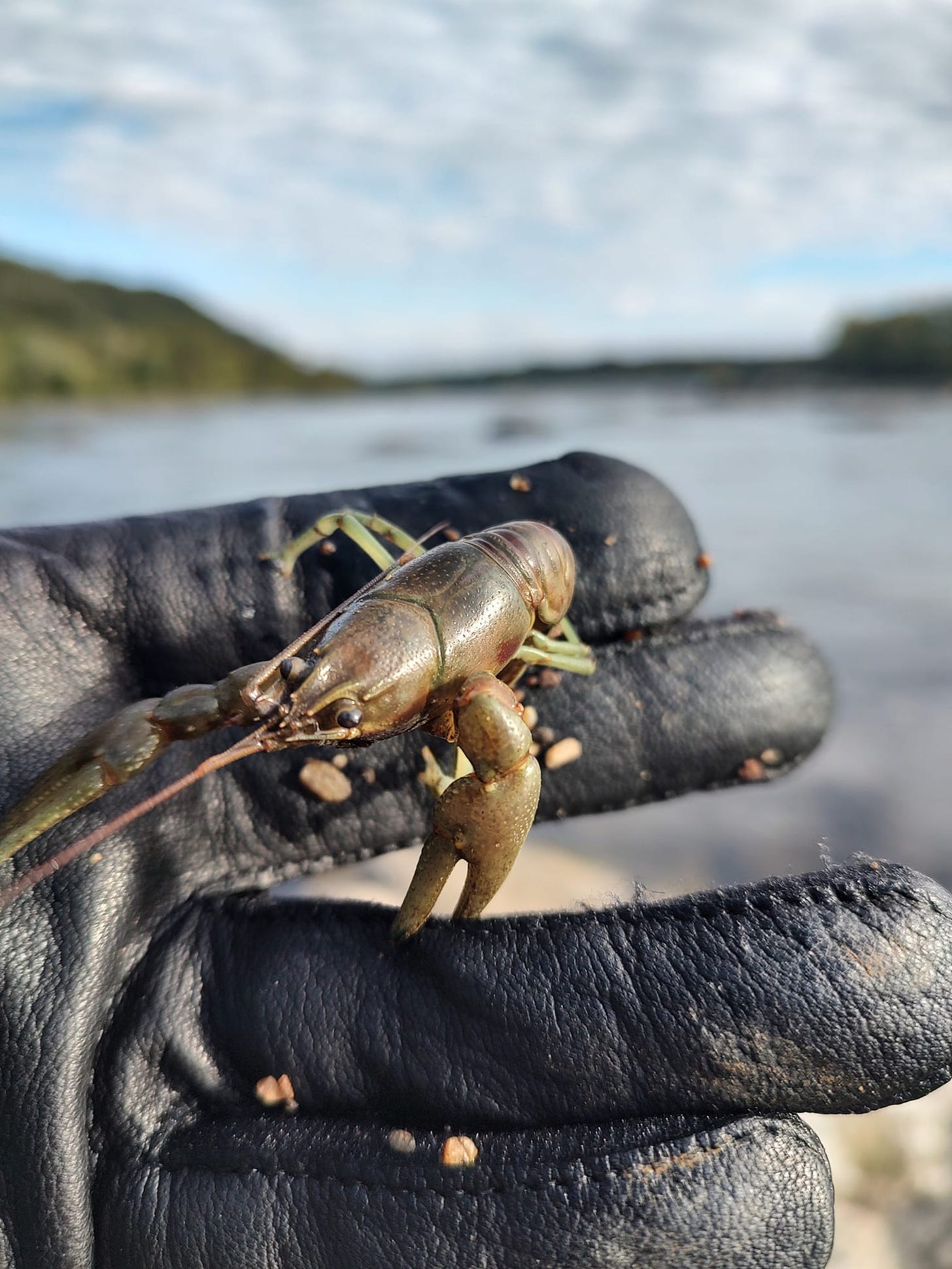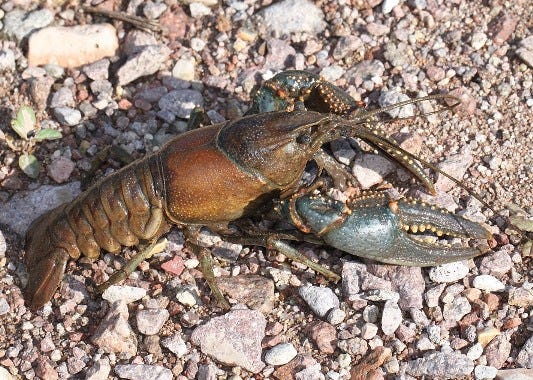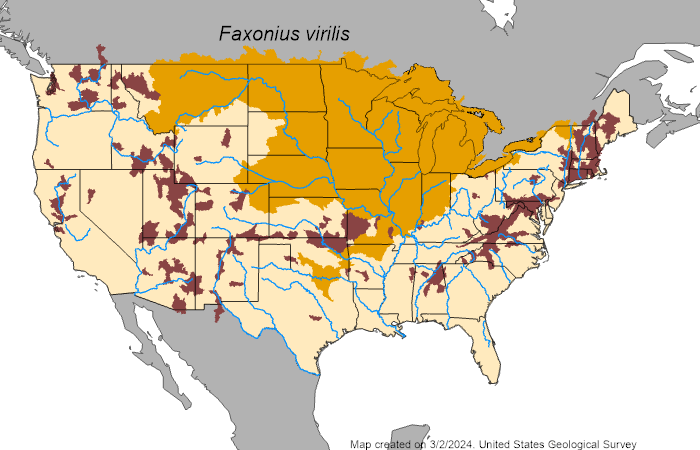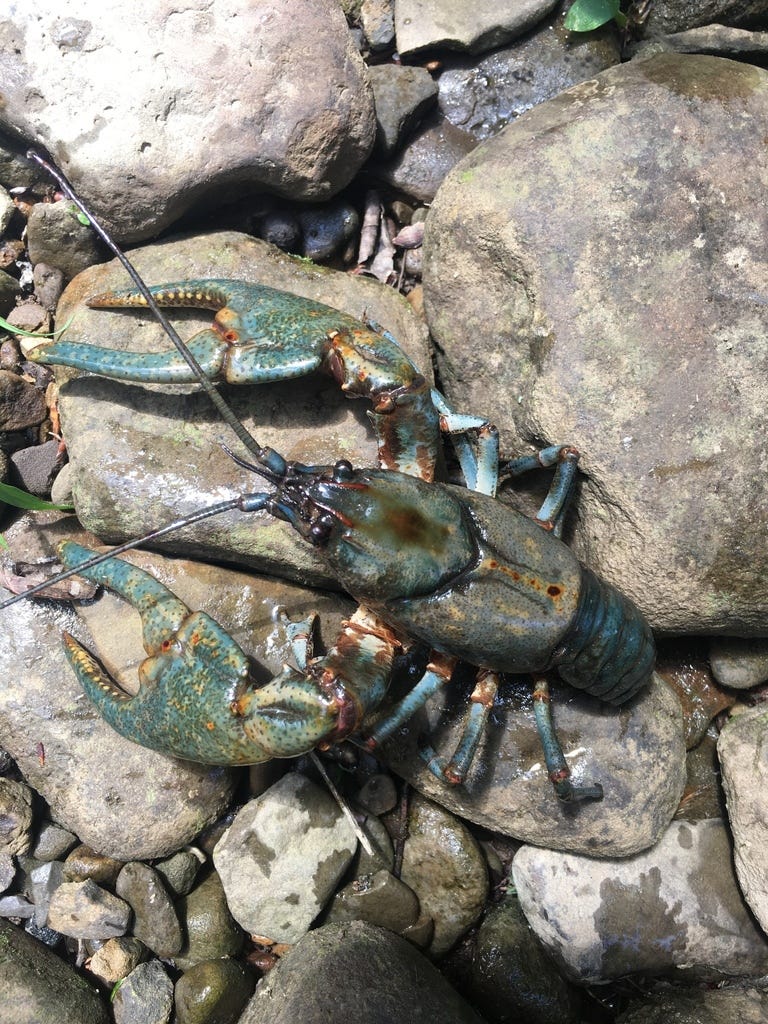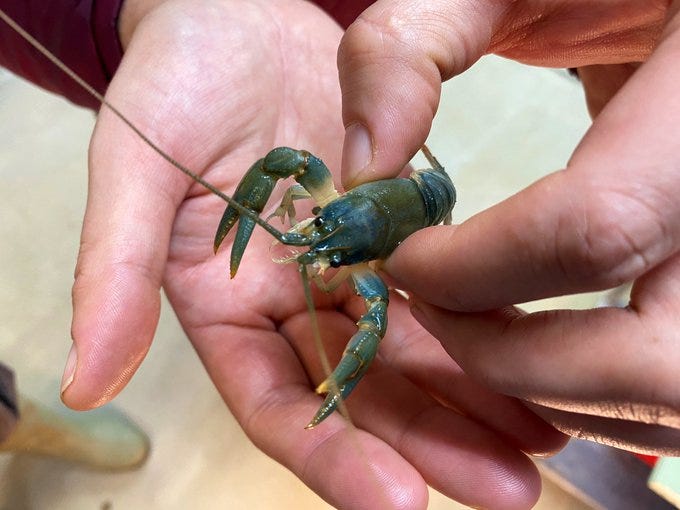Crayfish 101: The Things To Know
How Understanding Crayfish Behaviors Will Increase Your Smallmouth Catch Rates
The river systems are turning over again as we approach the end of March. Many have been playing the yo yo game for weeks now. The increased water levels and change in water clarity in many areas will play a direct role in the weeks to come as it influences the factors within the river ecosystem that impact catch rates for Smallmouth.
We hear so much about the impact of say water temperature on the spawn in terms of timing but often far too many neglect to correlate the water temperature and water levels along with clarity to the forage specie like Crayfish that Smallmouth prey upon during the pre spawn to feed up before the spawning cycle.
Crayfish in river systems are opportunistic omnivores, feeding on a wide variety of organic matter, plant material, invertebrates, and occasionally small fish. Their diet can include algae, detritus, aquatic plants, insect larvae, snails, small fish, and carrion.
Here's how water depth and clarity impact their behaviors and relationship to Smallmouth Bass:
Water Depth:
Shallow Water: In shallow water, crayfish are more exposed and vulnerable to predation, so they tend to be more cautious and retreat to cover more frequently. However, shallow areas often provide abundant food resources and shelter, particularly around rocks, logs, and vegetation, making them attractive feeding grounds for crayfish.
Deep Water: Crayfish may venture into deeper water to avoid predators or during periods of high flow or turbulence. Deep pools and pockets offer refuge from strong currents and may contain larger prey items, but crayfish are more likely to be scavenging or resting in these areas rather than actively foraging.
Water Clarity:
Clear Water: In clear water, crayfish rely more on camouflage and stealth to avoid detection by predators. They may exhibit slower, more deliberate movements and use available cover more effectively to conceal themselves. Clear water also allows crayfish to visually locate food items more easily, enhancing their foraging efficiency.
Turbid Water: In turbid or murky water, crayfish may rely more on tactile and chemical cues to locate food and assess their surroundings. Reduced visibility may make crayfish more vulnerable to predation, prompting them to stay closer to cover or retreat to deeper water. However, turbid water can also provide a degree of concealment for crayfish, making them less conspicuous to predators.
Relationship to Smallmouth Bass:
Smallmouth are voracious predators that commonly prey on crayfish in our river systems. The relationship between Crayfish and Smallmouth Bass is complex and dynamic, influenced by factors such as habitat availability, water temperature, prey abundance, and predator behavior.
Here's how water depth and clarity impact this relationship:
Shallow, Clear Water: In shallow, clear water, Smallmouth bass can visually detect crayfish more easily and may actively hunt them along rocky shorelines, riffles, and shallow flats. Crayfish, in turn, may exhibit more cautious behavior and rely on cover to avoid predation.
Deep, Turbid Water: In deep, turbid water, Smallmouth bass may rely more on their lateral line and sense of smell to locate crayfish. Crayfish may use cover and substrate features to evade detection, but reduced visibility can make them more vulnerable to ambush predation by Smallmouth bass.
Overall, crayfish and Smallmouth Bass share complex ecological interactions shaped by their respective behaviors, habitat preferences, and environmental conditions. Understanding these dynamics is essential for understanding how Smallmouth will relate to forage like Crayfish in our river systems.
One of the bigger myths out there is that Crayfish are merely rock dwellers. That Crayfish prefer or will always be located under or around rock. While Crayfish certainly will entertain rock the truth of the matter is Crayfish like bass love grass lines and other vegetation as well as structure cover like fallen timber in rivers. The grass is where most of the Crayfish food resources reside and often this factor draws the Crayfish to grass so to do the Crayfish draw the Smallmouth.
Crayfish are fascinating crustaceans found in various aquatic habitats, including river systems, streams, lakes, and ponds, throughout the Eastern United States. Understanding their behaviors, characteristics, and habitat preferences is crucial for both anglers and conservation efforts. Here's an overview of crayfish in Eastern U.S. river systems:
Habitat Preferences:
Crayfish inhabit a wide range of aquatic environments, from shallow riffles to deep pools, with preferences for specific substrate types such as rocks, gravel, sand, mud, and vegetation.
They seek shelter in natural structures like submerged logs, rocks, root masses, and artificial structures like bridge pilings and culverts.
Crayfish are typically found in areas with moderate to fast-moving water, although some species can tolerate slower currents.
Life Cycle:
Crayfish undergo a complex life cycle that includes several stages: egg, juvenile (or larval), subadult, and adult.
After mating, female crayfish carry fertilized eggs underneath their abdomens until they hatch, at which point the larvae cling to the female's swimmerets for protection.
Juvenile crayfish molt several times as they grow, shedding their exoskeleton to accommodate their increasing size.
Crayfish reach sexual maturity within 1-2 years, depending on species and environmental factors.
Lifespan varies among crayfish species but generally ranges from 2-5 years.
Reproduction:
Crayfish reproduction typically occurs in late spring and early summer when water temperatures rise, stimulating mating behavior.
Mating involves a courtship ritual where males deposit sperm packets (spermatophores) on the substrate, which females pick up to fertilize their eggs.
After fertilization, females carry the eggs until they hatch, usually within 2-4 weeks, depending on water temperature.
Female crayfish can produce hundreds to thousands of eggs per brood, contributing to their prolific reproductive potential.
Parental care varies among crayfish species, with some providing maternal care to their offspring while others offer minimal protection.
Preferred Water Temperatures and Clarities:
Crayfish are ectothermic, meaning their body temperature is regulated by their environment. They thrive in water temperatures ranging from 50-75°F (10-24°C), with optimal growth and activity occurring between 65-70°F (18-21°C).
Water clarity preferences vary among crayfish species, but many prefer habitats with moderate clarity, avoiding excessively turbid or murky waters that hinder visibility and foraging efficiency.
Clearer water allows crayfish to detect predators and prey more effectively and facilitates navigation and resource acquisition.
We should be seeing more Crayfish emerging from their holes in the coming weeks as the river settle back and the temperatures push north of 50 degrees but that does not mean that there are not various Crayfish species out and about right now as we have seen both Spineycheek and Virile Crayfish in the river even with the temps in the high forties. This most likely is a by product of the high water events of the last few weeks in multiple river systems and tributaries which can move not only river composition but also Crayfish themselves and scatter therm throughout the river.
The species of Crayfish within the region are abundant. There are probably close to four dozen specie of Crayfish that you may encounter and honestly you could encounter two or three different specie in some instances on the same trip. This can happen especially if you are a wade angler or chasing Smallies both in the main river but also creeks or feeder streams that enter a river system.
The Eastern United States is certainly home to a diverse array of crayfish species, including both native and non-native invasive species. Here's an overview of some prominent species found in the region:
Native Species:
Orconectes virilis (Northern Crayfish):
Native to various regions of North America, including the Eastern United States.
Typically found in streams, rivers, lakes, and ponds with moderate flow and rocky or sandy substrate.
Exhibits a greenish-brown coloration with lighter undersides and distinctive raised ridges on the carapace.
Plays an important ecological role as prey for fish and other aquatic predators and as a scavenger, contributing to nutrient cycling.
Orconectes rusticus (Rusty Crayfish): Now Abundant in Pennsylvania (Susquehanna River watershed)
Native to the Ohio River basin but has become invasive in parts of the Eastern United States.
Prefers clear, rocky streams and rivers but can tolerate a wide range of habitats.
Identified by its robust body and rusty-colored spots on the sides of the carapace.
Considered invasive due to its aggressive behavior, rapid reproduction, and displacement of native crayfish species.
Orconectes propinquus (Blue Ridge Crayfish):
Endemic to the Appalachian Mountains in the Eastern United States.
Inhabits small to medium-sized streams with rocky substrates and cool, well-oxygenated water.
Features a blue-gray coloration with lighter markings and distinctive spines on the carapace.
Plays a vital role in freshwater ecosystems as a predator and scavenger, contributing to the regulation of invertebrate populations.
Cambarus bartonii (Common Crayfish):
Widely distributed across the Eastern United States, inhabiting a variety of aquatic habitats.
Prefers streams, rivers, and lakes with substrates ranging from sand and gravel to mud and organic debris.
Exhibits variable coloration, ranging from brown and olive to reddish-brown, with darker markings on the carapace.
Serves as an important food source for fish, birds, and mammals and helps maintain water quality through scavenging.
Non-Native Invasive Species:
Procambarus clarkii (Red Swamp Crayfish):
Native to the southern United States but introduced to various regions, including parts of the Eastern United States.
Thrives in freshwater habitats such as swamps, marshes, ponds, and slow-moving streams.
Recognizable by its bright red coloration, elongated claws, and robust body.
Considered highly invasive due to its rapid reproduction, burrowing behavior, and ability to outcompete native crayfish species for resources.
Procambarus virginalis (Marbled Crayfish):
Originally from Florida, but has been introduced to other parts of the Eastern United States and beyond.
Typically found in freshwater habitats, including lakes, ponds, and rivers, with a preference for still or slow-moving water.
Characterized by its marbled brown and tan coloration and lack of sexual reproduction (all individuals are female).
Poses a significant threat to native biodiversity and ecosystems due to its high reproductive potential and ability to colonize new habitats rapidly.
These are just a few examples of the crayfish species found in the Eastern United States, highlighting both the diversity of native species and the challenges posed by invasive species to freshwater ecosystems and native biodiversity.
Others include the Virile Crayfish now the most abundant invasive non native Crayfish specie in Maryland but time will tell as the more aggressive Rusty Crayfish is making its way down into Maryland from Pennsylvania.
Procambarus fallax (Virile Crayfish):
Originally from the southeastern United States but introduced to Maryland and other parts of North America.
Prefers a variety of freshwater habitats, including streams, rivers, lakes, and reservoirs.
Exhibits variable coloration ranging from brown to greenish-gray, with distinctive claws and a robust body.
Poses a threat to native biodiversity and ecosystems due to its competitive interactions with native crayfish species and potential transmission of diseases.
Virile has directly impacted the native Spineycheek and especially the Allegheny Crayfish. Virile has a very interesting non native range mapping compared to others and as it has been identified in isolated areas throughout the country as well as predominately in the Appalachian range of Virginian, West Virginia, western Maryland and lower Pennsylvania.
Other than the Red Swamp Crayfish in the region the Virile can get the brightest of reds compared to the other four dozen or so crayfish species. Red Swamp is said to have been introduced here by man often time ordered and delivered decades ago from Louisiana and other places to the region and often sold as bait.
Maryland is home to several more native and non-native crayfish species of course, each with its own preferred habitats and distributions within the state's river systems. Many also are located in Virginia and West Virginia as well. Here's an overview of some prominent species found in Maryland:
Native Species:
Orconectes limosus (Spinycheek Crayfish):
Native to Maryland and other parts of the Eastern United States.
Typically found in streams, rivers, and lakes with sandy or gravelly bottoms and moderate flow.
Exhibits a brownish coloration with distinctive spines on the sides of the carapace.
Prefers well-oxygenated water and habitats with ample cover such as submerged vegetation, rocks, and woody debris.
Orconectes propinquus (Blue Ridge Crayfish):
Endemic to the Appalachian Mountains, including parts of Maryland.
Inhabits small to medium-sized streams with rocky substrates and cool, clear water.
Features a blue-gray coloration with lighter markings and prominent spines on the carapace.
Prefers riffles and runs where water flow is moderate to swift, providing suitable habitat for feeding and reproduction.
Orconectes virilis (Northern Crayfish):
Found throughout the Eastern United States, including Maryland.
Inhabits a variety of freshwater habitats, including streams, rivers, lakes, and ponds.
Typically prefers substrates of sand, gravel, or rocky debris and moderate water flow.
Plays an important role in freshwater ecosystems as a predator and scavenger, contributing to nutrient cycling and food webs.
Non-Native Invasive Species: (In addition to Virile Crayfish above)
Procambarus clarkii (Red Swamp Crayfish):
Native to the southeastern United States but introduced to Maryland and other regions.
Thrives in freshwater habitats such as swamps, marshes, ponds, and slow-moving streams.
Recognizable by its bright red coloration, elongated claws, and ability to burrow into banks.
Considered highly invasive due to its aggressive behavior, rapid reproduction, and displacement of native crayfish species.
While the Virile and Red Swamp Crayfish invasive species can also be found in parts of Virginia there are other species in Virginia not located in Maryland. One of them is the White River Crayfish.
Procambarus acutus (White River Crawfish):
Native to Virginia and other southeastern states.
Typically found in streams, rivers, and wetlands with slow-moving or stagnant water.
Features a slender body and distinctive white or light tan coloration.
Plays a role in aquatic ecosystems as both a predator and scavenger, feeding on organic matter and invertebrates.
Others like the Digger Crayfish are located but one of the species that management id attempting to sustain is the Big Sandy Crayfish. This one is on the threatened list and the hatchery at White Sulphur Springs, WV has been attempting to reproduce the Big Sandy for re introduction and if all goes well the hatchery will take on other threatened crayfish as well. (photo- wchstv.com)
The range for the Big Sandy has typically been west of the New River which has its on New River Crayfish that many may be familiar with given its ability to grow much larger than the typical species of the region. The size of the New River Crayfish and their population density could attribute to the giant Smallmouth population that exists in the New River today. (photo-Inaturalist)
Big Sandy Crayfish from the hatchery:
If you notice almost all of these crayfish species have differing coloration patterns so it essential to identify your river species and their preferred habitat preferences in order to locate Smallmouth in your river systems especially in late Spring through Summer where Smallies will feed on crayfish throughout the ecosystem.
During the spring, when Smallmouth are actively feeding and crayfish are becoming more abundant in river systems, many anglers should use presentations that mimic crayfish to entice strikes. Here are some of the most well known Smallmouth Bass fishing presentations that imitate crayfish in river systems during the Spring:
Crayfish-Imitating Jigs: Football jigs or finesse jigs rigged with soft plastic trailers that resemble crayfish are highly effective. Choose jig colors that match the natural crayfish found in the river, such as brown, green pumpkin, or orange. Work the jig along the river bottom, bouncing it off rocks and structure to mimic the movement of a crayfish.
Soft Plastic Crawfish Baits: (FINESSE/ BFS) Soft plastic crawfish baits, such as creature baits or crawfish imitations, can be rigged Texas-style or on a jighead. These baits have realistic appendages and antennae that mimic the movement of a fleeing crayfish. Experiment with different sizes and colors to match the crayfish in the river.
Crankbaits: Crankbaits that resemble crayfish are effective for covering water and enticing strikes from Smallmouth bass. Choose crankbaits with a realistic crayfish pattern and dive depth appropriate for the river depth. Retrieve the crankbait along rocky shorelines, submerged structure, and current seams where crayfish are likely to be found. ( Don’t JUST Throw RED guys!)
Spinnerbaits: Spinnerbaits with skirt colors that mimic crayfish, such as brown, orange, or green, can be effective for targeting Smallmouth bass in river systems. Slow roll the spinnerbait along the bottom, varying the retrieve speed to imitate the movement of a crayfish. Small compact ones seemingly work best for hook ups plus are the same size as forage. (Remember the ole Beetle Spin?)
Swimbaits: The new craze. Paddle-tail swimbaits in crayfish colors can be effective for imitating crayfish in river systems. Rig the swimbait on a jighead or weighted hook and retrieve it along the bottom or through current seams. The natural swimming action of the swimbait mimics a crayfish moving through the water. Prefer three inches or so but experiment in your river.
Topwater Lures: During low light conditions or when targeting shallow areas with rocky cover, topwater lures such as poppers, walking baits, or buzzbaits can imitate injured or struggling crayfish. Work the topwater lure along the surface, creating commotion to draw strikes from aggressive Smallmouth bass.
When fishing with crayfish imitations in river systems during the spring, it's essential to vary your presentations, retrieve speeds, and lure sizes to match the behavior of the crayfish and the feeding preferences of Smallies. Pay attention to water temperature, current flow, and the presence of structure and cover to maximize your chances of success. The timing may varying from one river to the next. While one river flow may be impacted by rains another may not given its topography and the direction the river current may flow. Always use your resources like NOAA data for water levels and projected changes to assist you in your your next river trip Chasing Smallies.
If you enjoy reading——I know most prefer the video format these days thank to the internet and social media—-but if you do please SUBSCRIBE to our FREE Newsletter so we can share more with you in yiour INBOX but also FOLLOW us on Facebook:
Smallie Chaser River Bassin Community:
https://www.facebook.com/groups/885248796934955




